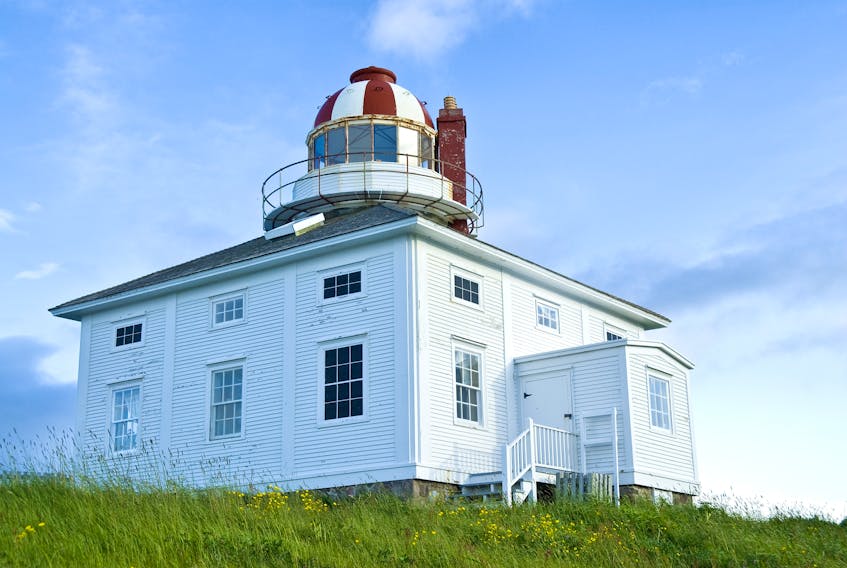By James E. Candow
It is time for Parks Canada to atone for its sins at Cape Spear Lighthouse National Historic Site. Those sins include the destruction of important cultural resources, the presentation of a fiction to the visiting public, and the exclusion of the Cantwell lightkeeping dynasty from the site’s official narrative.
Erected in 1835-36, old Cape Spear Lighthouse was in the Cantwells’ care from 1846 until 1955, when the federal Department of Transport (DOT) moved the light mechanism to a newly erected lighthouse nearby. Head keeper Frank Cantwell shifted to the new facility and in 1969 was succeeded by his son, Gerry, who remained until 1997, when the station became fully automated. By then, five generations of Cantwells had come and gone at the Cape, a record of service unequalled in Canadian lighthouse history.
Until 1971, the Cantwells lived at the Cape, tending livestock and growing much of their own food. Their outbuildings included a barn, coal shed, chicken coop, well house, privies, and garage. They also improved the original lighthouse to make it more livable, a process that began in 1850, when a linny was added along its south side.
A defining feature of Newfoundland vernacular architecture, the linny was a slope-roofed, one-storey rectangular structure that functioned as porch and storeroom. As at Cape Spear, it was invariably located on the same side of the house as the kitchen. Vernacular architecture refers to features made from local materials and whose design comes from local tradition, hence the expression “architecture without architects.”

A second linny was built on the north side in 1865, to which a third was added in 1872 to accommodate the extended Cantwell family. In 1912, a one-storey bungalow was erected next to the southside linny as home for a new second assistant keeper who quickly disappeared. When he did, the Cantwells took over the bungalow and joined it to the linny by an enclosed passageway.
As part of its mid-1950s modernization program, DOT planned to demolish the old lighthouse, and would have done so but for Frank Cantwell, who claimed that it could not touch the building because it belonged to the Cantwell family. For standing up to DOT, Frank became a local and national folk hero, and his fame began attracting tourists to the Cape. While lawyers wrestled with the ownership question, the Historic Sites and Monuments Board of Canada took an interest and in 1962 declared that the old lighthouse was of national historic significance.
The linnies, bungalow and outbuildings were all intact in 1964, when Ottawa-based Parks Canada (then known as the National Parks Branch) sent architect Jack Stevens to the Cape to conduct an assessment. Observing that the building had changed over time, Stevens recommended that it be restored to what he called Phase 3 of its evolution, namely, the original building plus the 1850 and 1865 southside and northside linnies. This sensible advice would have preserved most of the vernacular features and put the Cantwells front and centre in any interpretive program, as they deserved to be.
Unfortunately, Stevens’ report got lost in a decade-long bureaucratic fog, during which Parks Canada demolished the 1912 bungalow and the Cantwells’ outbuildings. There matters stood until the mid-1970s, when the site’s development became a priority for Parks Canada’s new Atlantic Regional Office in Halifax. Alas, the professional staff assigned to the project were strangers to Newfoundland and its history. The results were disastrous.

In 1976, restoration architects achieved the impossible by writing a report on the old lighthouse without mentioning the Cantwells. Demonstrating ignorance of vernacular architecture, they called the linnies “leanies,” claimed that they “bastardized” the lighthouse and, overstepping their bounds, concluded that they “would not be suitable for visitation, or interesting to the public.” Compare this with local expert Shane O’Dea’s judgment that vernacular architecture is “the most potent manifestation of Newfoundland’s culture.”
Guided by the report, senior management ordered the demolition of the linnies and the restoration of the lighthouse to the 1835-40 period, thereby excluding the Cantwells from the building’s interpretation. This was a strange form of gratitude to Frank Cantwell, without whom there would have been no lighthouse and thus no national historic site.
Curators subsequently filled the building with generic period furniture, most of it sourced in Nova Scotia. Other than the kitchen, the layout and uses of the interior space were guesswork. Bedrooms were assigned to an assistant keeper and the headkeeper’s children, this despite any evidence for an assistant keeper in the period, or for keeper Emanuel Warre being married, let alone having children. Parks Canada also ignored historical evidence for the two exterior paint schemes that were used between 1835 and 1840, opting instead for an inappropriate hodgepodge.
Moreover, the building lacked a light, without which a lighthouse is just a house.
This abomination opened to the public in 1982. Fast forward to today and little has changed except for improvements to the site’s trails, visitor facilities and Second World War bunkers, which, while important, have nothing to do with the reasons for the site’s national historic significance.
The destruction of cultural resources, the presentation of a fiction, and the exclusion of the Cantwells from the official narrative are a stain on Parks Canada, which should atone while Frank and Margaret Cantwell’s children are still around. An apology from the minister responsible for Parks Canada, Jonathan Wilkinson, would be a good starting point.
James E. Candow writes from Dartmouth, N.S.









